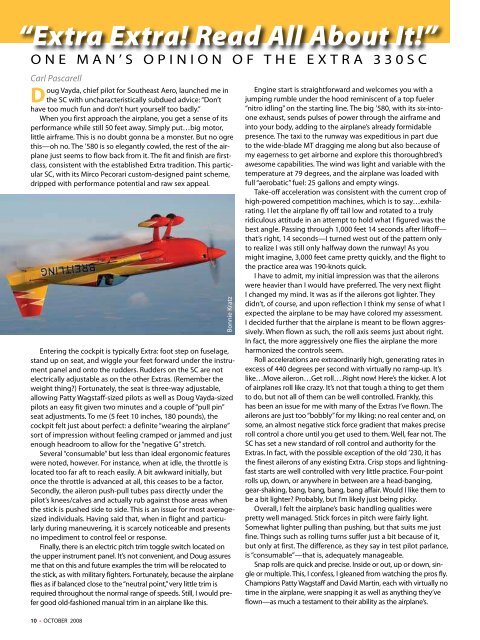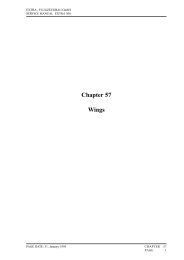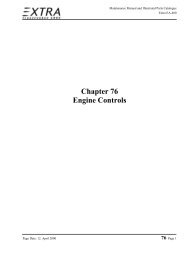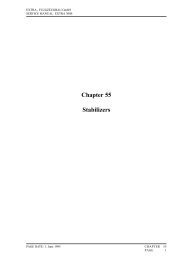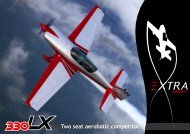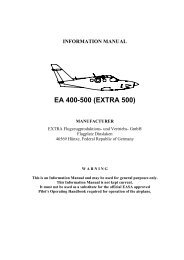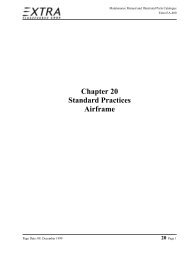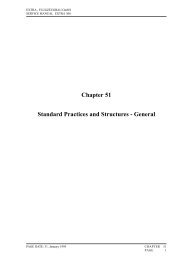2008-10 - Extra Aircraft
2008-10 - Extra Aircraft
2008-10 - Extra Aircraft
Create successful ePaper yourself
Turn your PDF publications into a flip-book with our unique Google optimized e-Paper software.
“<strong>Extra</strong> <strong>Extra</strong>! Read All About It!”<br />
OnE MAn’S OPInIOn OF THE ExTRA 330SC<br />
Carl Pascarell<br />
Doug Vayda, chief pilot for Southeast Aero, launched me in<br />
the SC with uncharacteristically subdued advice: “Don’t<br />
have too much fun and don’t hurt yourself too badly.”<br />
When you first approach the airplane, you get a sense of its<br />
performance while still 50 feet away. Simply put…big motor,<br />
little airframe. This is no doubt gonna be a monster. But no ogre<br />
this—oh no. The ’580 is so elegantly cowled, the rest of the airplane<br />
just seems to flow back from it. The fit and finish are firstclass,<br />
consistent with the established <strong>Extra</strong> tradition. This particular<br />
SC, with its Mirco Pecorari custom-designed paint scheme,<br />
dripped with performance potential and raw sex appeal.<br />
Entering the cockpit is typically <strong>Extra</strong>: foot step on fuselage,<br />
stand up on seat, and wiggle your feet forward under the instrument<br />
panel and onto the rudders. Rudders on the SC are not<br />
electrically adjustable as on the other <strong>Extra</strong>s. (Remember the<br />
weight thing?) Fortunately, the seat is three-way adjustable,<br />
allowing Patty Wagstaff-sized pilots as well as Doug Vayda-sized<br />
pilots an easy fit given two minutes and a couple of “pull pin”<br />
seat adjustments. To me (5 feet <strong>10</strong> inches, 180 pounds), the<br />
cockpit felt just about perfect: a definite “wearing the airplane”<br />
sort of impression without feeling cramped or jammed and just<br />
enough headroom to allow for the “negative G” stretch.<br />
Several “consumable” but less than ideal ergonomic features<br />
were noted, however. For instance, when at idle, the throttle is<br />
located too far aft to reach easily. A bit awkward initially, but<br />
once the throttle is advanced at all, this ceases to be a factor.<br />
Secondly, the aileron push-pull tubes pass directly under the<br />
pilot’s knees/calves and actually rub against those areas when<br />
the stick is pushed side to side. This is an issue for most averagesized<br />
individuals. Having said that, when in flight and particularly<br />
during maneuvering, it is scarcely noticeable and presents<br />
no impediment to control feel or response.<br />
Finally, there is an electric pitch trim toggle switch located on<br />
the upper instrument panel. It’s not convenient, and Doug assures<br />
me that on this and future examples the trim will be relocated to<br />
the stick, as with military fighters. Fortunately, because the airplane<br />
flies as if balanced close to the “neutral point,” very little trim is<br />
required throughout the normal range of speeds. Still, I would prefer<br />
good old-fashioned manual trim in an airplane like this.<br />
Engine start is straightforward and welcomes you with a<br />
jumping rumble under the hood reminiscent of a top fueler<br />
“nitro idling” on the starting line. The big ’580, with its six-intoone<br />
exhaust, sends pulses of power through the airframe and<br />
into your body, adding to the airplane’s already formidable<br />
presence. The taxi to the runway was expeditious in part due<br />
to the wide-blade MT dragging me along but also because of<br />
my eagerness to get airborne and explore this thoroughbred’s<br />
awesome capabilities. The wind was light and variable with the<br />
temperature at 79 degrees, and the airplane was loaded with<br />
full “aerobatic” fuel: 25 gallons and empty wings.<br />
Take-off acceleration was consistent with the current crop of<br />
high-powered competition machines, which is to say…exhilarating.<br />
I let the airplane fly off tail low and rotated to a truly<br />
ridiculous attitude in an attempt to hold what I figured was the<br />
best angle. Passing through 1,000 feet 14 seconds after liftoff—<br />
that’s right, 14 seconds—I turned west out of the pattern only<br />
to realize I was still only halfway down the runway! As you<br />
might imagine, 3,000 feet came pretty quickly, and the flight to<br />
the practice area was 190-knots quick.<br />
I have to admit, my initial impression was that the ailerons<br />
were heavier than I would have preferred. The very next flight<br />
I changed my mind. It was as if the ailerons got lighter. They<br />
didn’t, of course, and upon reflection I think my sense of what I<br />
expected the airplane to be may have colored my assessment.<br />
I decided further that the airplane is meant to be flown aggressively.<br />
When flown as such, the roll axis seems just about right.<br />
In fact, the more aggressively one flies the airplane the more<br />
harmonized the controls seem.<br />
Roll accelerations are extraordinarily high, generating rates in<br />
excess of 440 degrees per second with virtually no ramp-up. It’s<br />
like…Move aileron…Get roll….Right now! Here’s the kicker. A lot<br />
of airplanes roll like crazy. It’s not that tough a thing to get them<br />
to do, but not all of them can be well controlled. Frankly, this<br />
has been an issue for me with many of the <strong>Extra</strong>s I’ve flown. The<br />
ailerons are just too “bobbly” for my liking: no real center and, on<br />
some, an almost negative stick force gradient that makes precise<br />
roll control a chore until you get used to them. Well, fear not. The<br />
SC has set a new standard of roll control and authority for the<br />
<strong>Extra</strong>s. In fact, with the possible exception of the old ’230, it has<br />
the finest ailerons of any existing <strong>Extra</strong>. Crisp stops and lightningfast<br />
starts are well controlled with very little practice. Four-point<br />
rolls up, down, or anywhere in between are a head-banging,<br />
gear-shaking, bang, bang, bang, bang affair. Would I like them to<br />
be a bit lighter? Probably, but I’m likely just being picky.<br />
Overall, I felt the airplane’s basic handling qualities were<br />
pretty well managed. Stick forces in pitch were fairly light.<br />
Somewhat lighter pulling than pushing, but that suits me just<br />
fine. Things such as rolling turns suffer just a bit because of it,<br />
but only at first. The difference, as they say in test pilot parlance,<br />
is “consumable”—that is, adequately manageable.<br />
Snap rolls are quick and precise. Inside or out, up or down, single<br />
or multiple. This, I confess, I gleaned from watching the pros fly.<br />
Champions Patty Wagstaff and David Martin, each with virtually no<br />
time in the airplane, were snapping it as well as anything they’ve<br />
flown—as much a testament to their ability as the airplane’s.<br />
The subtleties of snap rolls and rollers are one thing, but to<br />
me, the truly impressive nature of the airplane is evident in the<br />
“wow” maneuvers. You know the “wow” maneuvers—<strong>10</strong>-roll<br />
torque rolls, double and triple nose-over-tail tumbles, knifeedge<br />
spins that you can barely hold onto, and tiny “micro loops”<br />
at 60 knots. These are the “YEE HA!” things that make the airplane<br />
so exhilarating and so memorable.<br />
Having quickly gained confidence in the SC, my second flight<br />
was in the low-altitude practice box at the St. Augustine Airport<br />
in Florida. My flight was a chaotic mass (or mess as some would<br />
have it) of one-after-the-other, body-punishing attempts to do<br />
all I could in 20 minutes.<br />
Vertical performance was exceptional, and I’m almost embarrassed<br />
to admit I actually pulled power from time to time to<br />
stay down in the box and keep from exceeding the 3,500-foot<br />
box ceiling and/or the 220 knot redline. now that’s precisely the<br />
type of problem I enjoy having in an airplane. I particularly liked<br />
the stability the airplane exhibited when stuck in the vertical. It<br />
was almost as if the airplane was flying with an “attitude hold”<br />
engaged. Once stuck there, very little attention was required to<br />
maintain the vertical. This was in part due to the low, off-speed<br />
trim requirement and was generally true for all lines and angles.<br />
I tended to concentrate on vertical and point maneuvers if<br />
for no other reason than they are so well done by the SC. Vertical<br />
four points up, inside, outside, inside triple vertical eights<br />
or “snowmen,” and the “how long is this gonna go on” torque<br />
rolls were pushing me over the “too much fun limit” Doug had<br />
warned me about.<br />
All high-alpha maneuvering was as well behaved and controllable<br />
as any aerobatic plane I’ve flown, the “micro loops”<br />
in particular. Starting at 60 knots and flown in full buffet with<br />
almost full aft stick, the roll and yaw axis throughout the loop<br />
were completely controllable with conventional control input,<br />
so much so that from the ground it was not apparent any buffet<br />
existed at all.<br />
All maneuvers were thrilling to say the least, but it was the<br />
knife-edge spins that captured my attention more than any<br />
other maneuver. Entry into the “knife” from a hammerhead was<br />
easily accomplished, even when the hammerhead pivot was<br />
sloppily flown. The pitch rate from the onset was eye-popping<br />
and almost beyond my ability to adequately hang onto. Three<br />
turns was the most I could hang onto, and even at that, I landed<br />
with the G-meter pegged on the negative end.<br />
My 20 minutes were up in short order and, taxiing back after<br />
landing, I recalled again what Doug had said about having too<br />
much fun. I knew what he meant. And I didn’t listen. With -+9Gs<br />
and -6 Gs on the meter, I dragged myself out of the airplane<br />
sweaty, bruised, and exhausted, huffing and puffing as if I’d just<br />
run 5 miles. I’m no stranger to high performance and generally<br />
not easily impressed, but man was that fun! It’s going to<br />
be interesting to see how the airplane’s future develops in the<br />
hands of true competition professionals.<br />
<strong>10</strong> • OCTOBER <strong>2008</strong> SPORT AEROBATICS • 11


